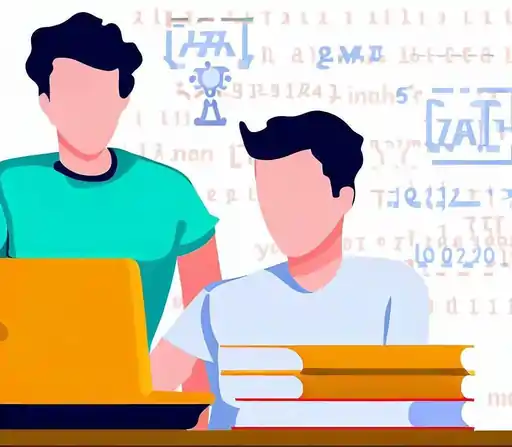Unsupervised Learning and MATLAB: A Student's Guide to Assignment Success

MATLAB has become a powerful tool in the field of data analysis and artificial intelligence, enticing researchers, students, and engineers alike. One of its most important uses is in the area of unsupervised learning, a key area of machine learning where algorithms automatically identify complex patterns and structures from unlabeled data. This blog explores this enthralling topic in-depth, focusing on the profound significance of MATLAB's unsupervised learning techniques and their astounding potential for academic assignments, particularly for master's students navigating their academic careers in universities with the help of a MATLAB assignment expert. As we begin this in-depth investigation, we will explore the fundamentals of unsupervised learning, learn about the variety of algorithms it encompasses, and observe how the combination of MATLAB's expertise and students' curiosity opens up new avenues for comprehension, problem-solving, and innovation. Through the use of MATLAB, students can embrace the world of unsupervised learning and are ready to discover the secrets of data. This environment of curiosity-driven inquiry opens the door for ground-breaking research and academic excellence. If you need help with an Unsupervised Learning Assignment, don't hesitate to reach out to a MATLAB expert for guidance and support.

Understanding Unsupervised Learning
In the world of machine learning, assumes a crucial role in unraveling the essence of this fundamental technique. Unsupervised learning, in contrast to supervised learning, searches for patterns and structures without a predetermined result in unlabeled data. Unsupervised learning brings together related data points using clustering algorithms like "k-means," "DBSCAN," and "hierarchical clustering," making it easier to explore and analyze the data. Another crucial component of unsupervised learning is Principal Component Analysis (PCA), which allows for data dimensionality reduction and simplifies complex datasets while preserving crucial information. Unsupervised learning must be used in situations where understanding underlying relationships and uncovering novel insights become crucial due to the lack of labeled data. Understanding unsupervised learning paves the way for utilizing its power to make informed decisions, extract useful information from raw data, and explore untapped opportunities in the ever-evolving world of machine learning and data science. Its potential applications in diverse fields include social network analysis, anomaly detection, and image segmentation.
Clustering
A fundamental unsupervised learning technique called clustering aims to group related data points according to particular features or characteristics. Powerful toolboxes and functions are available in MATLAB for effective clustering analysis. The well-known 'k-means' algorithm divides data into k clusters and places each data point in the cluster with the closest mean. Additionally, MATLAB has the ability to perform hierarchical clustering (called "linkage") and density-based clustering (called "DBSCAN"), giving users the freedom to select the method that will work best for their particular dataset.
Principal Component Analysis (PCA)
Another popular unsupervised learning technique is principal component analysis (PCA), which reduces the dimensionality of data while preserving essential information. The 'pca' function in MATLAB makes it easier to compute principal components and enables users to view high-dimensional data in a lower-dimensional space. Less dimensional data representation makes it easier to explore and interpret underlying patterns, which produces insightful information.
Anomaly Detection
The process of anomaly detection, which involves locating unusual events or outliers in data, greatly benefits from unsupervised learning. Users can use a variety of anomaly detection methods, including the one-class SVM (Support Vector Machine) and the Isolation Forest algorithm, thanks to the extensive support provided by MATLAB. These techniques are very good at finding anomalies and unusual behavior in datasets, which makes them extremely useful in real-world applications like fraud detection and fault diagnosis where spotting anomalous patterns is crucial.
Advantages of Using MATLAB for Unsupervised Learning
MATLAB offers a plethora of advantages when it comes to implementing unsupervised learning techniques, making it a preferred choice among researchers and students alike. One of the significant advantages lies in the comprehensive toolbox support that MATLAB provides for machine learning and data analysis. The Statistics and Machine Learning Toolbox, in particular, equips users with a wide array of functions tailored for clustering, dimensionality reduction, and statistical analysis, streamlining the implementation of unsupervised learning algorithms. Another compelling advantage is MATLAB's ease of data visualization, enabling users to create informative and visually appealing representations of their unsupervised learning results. The extensive set of plotting functions and interactive visualization capabilities simplifies the interpretation and communication of complex findings. Furthermore, MATLAB seamlessly integrates preprocessing techniques into the workflow, facilitating data preparation with features like data scaling, normalization, and feature selection. These advantages collectively empower users to unlock the full potential of unsupervised learning methods and leverage MATLAB's capabilities for enriched data analysis and visualization, ultimately driving the success of academic assignments and research endeavors.
Comprehensive Toolbox Support
One of the standout features of MATLAB is its extensive toolbox support tailored specifically for machine learning and data analysis. The Statistics and Machine Learning Toolbox takes the spotlight, providing a rich repository of functions dedicated to clustering, dimensionality reduction, and statistical analysis. This toolbox streamlines the implementation of unsupervised learning algorithms, making it a boon for researchers and students seeking to delve into the world of data exploration and pattern recognition. With a wide range of tools at their disposal, users can confidently navigate through complex datasets and extract meaningful insights, unlocking the full potential of unsupervised learning with MATLAB's robust toolbox support.
Easy Data Visualization
Data visualization acts as a critical bridge between raw data and meaningful interpretations. In this aspect, MATLAB stands out with its extensive plotting functions and interactive visualization capabilities. Users can effortlessly create visually appealing representations of unsupervised learning results, enabling them to gain deeper insights into data patterns and relationships. Whether it's generating scatter plots to visualize clustering outcomes or biplots to interpret Principal Component Analysis (PCA) results, MATLAB's user-friendly visualization tools facilitate effective communication of complex findings. By harnessing the power of data visualization in MATLAB, researchers and students can enhance their data analysis prowess and present their discoveries with utmost clarity and impact.
Seamless Integration with Preprocessing
Preparing data for analysis is a critical aspect of any machine learning workflow, and MATLAB excels in this regard by offering seamless integration with preprocessing techniques. Data scaling, normalization, and feature selection are essential steps in data preparation, ensuring that the unsupervised learning algorithms perform optimally. MATLAB's user-friendly interface and built-in preprocessing functions simplify the data preparation process, allowing users to clean and transform their datasets efficiently. By seamlessly integrating preprocessing with unsupervised learning, MATLAB empowers users to approach their analyses with confidence, ensuring that the data is in the best possible shape for uncovering hidden patterns and extracting meaningful insights.
Harnessing Unsupervised Learning in Assignments
It is impossible to overstate the potential of unsupervised learning techniques in academic assignments. Students can explore new facets of data exploration and analysis by utilizing the power of unsupervised learning techniques, which will improve the standard and depth of their assignments in a variety of subject areas. The academic journey is further improved by utilizing MATLAB's unsupervised learning implementation capabilities. As students use clustering algorithms to pinpoint distinct communities or groups within networks, social network analysis becomes more insightful. With MATLAB's unsupervised learning tools, image segmentation is a breeze, allowing students to dive into computer vision and object recognition tasks with ease. Additionally, MATLAB's unsupervised learning makes it possible for students to segment customers based on their preferences and behaviors, paving the way for targeted marketing strategies. This is beneficial for market segmentation assignments. In-depth anomaly detection using MATLAB also equips students to recognize outliers and atypical patterns, providing critical insights in areas like fraud detection and fault diagnosis. Students can improve their academic performance and develop crucial skills in data analysis and machine learning for future endeavors by incorporating unsupervised learning techniques with MATLAB into their assignments.
Social Network Analysis
Social network analysis is a powerful tool for understanding the complex connections and relationships between people or entities in the field of sociology or social sciences. Students can identify distinct communities or groups within the network and draw insightful conclusions by using clustering algorithms and unsupervised learning techniques on social network data. Understanding these network structures can help us better understand social dynamics and enable informed decision-making in a variety of social contexts by illuminating influential nodes, communication patterns, and information flow.
Image Segmentation
Image segmentation is essential for computer vision applications and object recognition in image processing tasks. Students can effectively segment images into meaningful regions using MATLAB's unsupervised learning algorithms, enabling them to quickly analyze particular objects or regions of interest. Researchers can explore individual components by segmenting images into distinct parts, enabling in-depth analysis and manipulation of visual data. Precise image segmentation improves the accuracy and efficiency of subsequent processing steps in a variety of industries, including medical imaging, autonomous vehicles, and augmented reality.
Market Segmentation
Understanding market trends and customer segments is essential for success in business and marketing assignments. Students can segment customers based on behavior, preferences, or purchasing patterns thanks to unsupervised learning techniques in MATLAB. Customers can be divided into distinct segments, allowing researchers to gain hidden knowledge about consumer needs and preferences. This information forms the basis for targeted marketing campaigns. Businesses can tailor their goods or services to cater to particular customer groups through market segmentation analysis, optimizing marketing efforts, and enhancing customer satisfaction. Students are given the tools to fully realize the potential of market segmentation in a dynamic business environment through the use of unsupervised learning techniques in MATLAB.
Conclusion
The ability of a master's student to complete challenging assignments and research projects can be significantly improved by becoming proficient in unsupervised learning techniques in MATLAB. Students can easily implement a variety of unsupervised learning algorithms, such as K-Means, PCA, and GMM, to explore, analyze, and gain meaningful insights from their datasets thanks to MATLAB's user-friendly interface and a large library of functions. Students can maximize the potential of their assignments and contribute significantly to their fields of study by utilizing these unsupervised learning techniques. In order to conduct research and analyze data more effectively, students need to be able to recognize patterns, group data points, and reduce dimensionality. Master's students will undoubtedly find creative solutions and advance knowledge and technology in their academic careers and beyond as they continue to explore the vast capabilities of MATLAB and unsupervised learning. So start your unsupervised learning journey with MATLAB and discover all the opportunities it holds for your projects and future endeavors.